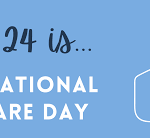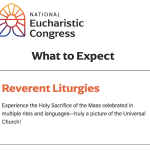St. Benedict’s spirituality includes an emphasis on autonomous communities as well as stability. Benedictine monks or sisters who resided in a particular community committed to staying in that particular place and with those particular religious. This contrasts with the practices of other religious orders and diocesan priests who are often sent from one location to another.
The need for connection
In today’s world, we’re less and less connected to our neighborhood and neighbors. We may walk out of our houses on smartphones, hop into our cars, and drive to work; versus walking out looking for a neighbor to greet and walking to our local place of worship or employment.
Stability
We have cars and Uber and trains and more; and phones for social contact. But what about Benedict’s spirituality—to stabilize in a particular place and develop autonomy with others in that place?
It may seem like an impractical ideal in today’s world, but I have a feeling we will realize, more and more, that this lifestyle is needed, even amid the technological revolution. We will crave stability, a place to which we develop an attachment, and connection with those physically close to us.
Science supports stability
Interestingly, but not surprisingly, science supports Benedictine spirituality. Thank you, St. Benedict, for revealing transcendental truths to us, well before we could figure them out scientifically.
So what exactly does science say?
Place attachment
Particular places
There’s a fascinating literature in psychology on place attachment. It’s just like what it sounds like- it’s tendency to attach to particular places. These might be annual vacation spots, places of worship, schools, or our very own neighborhoods (maybe even all of the above).
How does place attachment develop?
Place attachment involves feelings of affection and other positive emotions in response to a particular place. It is evoked when individuals feel safe and secure in their environment and have developed connections with it over time. It involves the encoding and retrieval of memories associated with the particular place. It may also involve a sense that the place fulfills one’s needs or helps one achieve particular goals.
If you want to find out more about place attachment, I recommend this scholarly article by Korpela (2012) that delves into some of the theories behind place attachment.
You might also find this interesting- apparently place attachment fosters the degree to which we perceive meaning in life.
My own place attachment
I can give an example. Every year, my family travels to Maine for an annual vacation. It’s beautiful, and we visit the same precious places every year, like the “little beach,” “the big beach,” and the lighthouse. We even take pride and pleasure enjoying the trip to the grocery store, where we just might see the same cashier or store manager from years ago. Each moment, there are strong, positive emotions that occur in response to these places- and it’s not just their beauty; it’s also the connection we have developed with them over time.
Pocahontas’ place attachment
Another fascinating example of place attachment comes from the Disney movie, Pocahontas. Recall the song, “Colors of the Wind,” and Pocahantas singing:
But I know every rock and tree and creature
Has a life, has a spirit, has a name
….The rainstorm and the river are my brothers
The heron and the otter are my friends
And we are all connected to each other
In a circle, in a hoop that never ends
It sounds like Pocahontas has some serious place attachment to her native land. Wouldn’t it be nice if we all felt a bit more connected to the place in which we reside?
Benedictine spirituality in the world today
Living Benedictine spirituality in today’s world doesn’t seem so far-fetched.
In fact, there are countless intentional communities in which individuals strive to be present to their neighbors, like this The Simple Way in Philadelphia.
Also, more and more individuals also strive to connect with their local place. And, nonprofits emerge with this mission, such as Science and Sustainability in Newark, NJ, which invites residents to create sustainable, local food sources in the city.
How to live Benedictine spirituality in the world today
So how to begin? Well, maybe we can start by recognizing the beauty and dignity of each person around us; taking breaks from technology; and looking to local resources to meet our needs. We might consider gardening or beautifying our local communities in some way, and maybe even doing so in collaboration with nearby others.
All in all, there are countless opportunities to live this research-backed, Benedictine spirituality in today’s world. As we do so, we just might find that we are truly “connected to each other” (Colors of the Wind).
St. Benedict, pray for us!
















